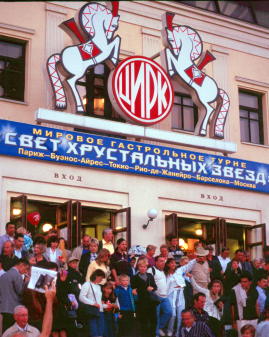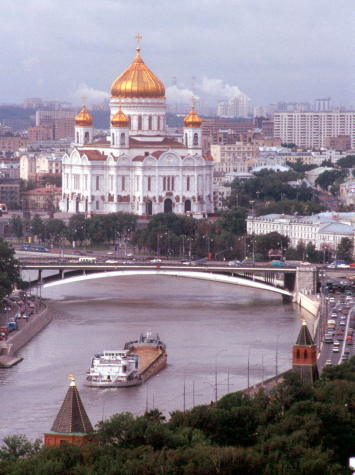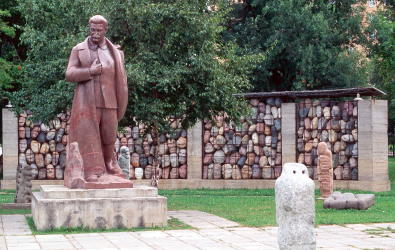 “Ladeeeez
and Gentlemen! Let zee show begin!”
“Ladeeeez
and Gentlemen! Let zee show begin!”Unlike 1984, writer Katharine Fletcher found no queues, and discovered a vibrant, modern city
Text and photographs by Katharine Fletcher
 “Ladeeeez
and Gentlemen! Let zee show begin!”
“Ladeeeez
and Gentlemen! Let zee show begin!”
A thousand people held their breath as darkness retreated to glimmers of gray. Adults gasped. Several hundred children waved glittering toy flashlights, creating a fantastical effect under Moscow State Circus’ permanent “Big Top.”
Poof! Up came the lights. Clowns, jugglers, and acrobats performed intricate acts, leaping onto one another’s shoulders, jumping through fiery hoops, landing adroitly on their skates on the ice-covered circus ring.
After the show, a happy crowd spilled onto the streets, faces radiating pleasure. Lovers strolled arm in arm, while sleepy children nestled into their parent’s arms. Tourists like me relived the acts, amicably debating their favourite moments in French, English, German, and Japanese.
Russians adore the circus and because “everyone” goes, it’s a great spot to visit if you want to get an insider’s glimpse into what makes Muscovites tick.
I was particularly excited to return to Moscow last August, to capture its mood after perestroika and glasnost. It was precisely seventeen years ago on, August 27, 1984, when my husband Eric and I first visited, homeward bound after a 14 month backpacking world trip. That day, the Trans Siberian Express pulled into the Moscow station, bang on time. I remember wondering, what would Moscow be like?
My journal entry reads, “At 4:40 precisely we pull into the Moscow Station... It is a hive of activity and the people are a parody of themselves: babushkas all kerchief-clad, big thick legs in knee-high stockings and red socks, clunky shoes and huge bulky overcoats. Young women attempt a fashionable look -- a few achieve a hint of glamour. Everyone looks grim, tired and in a big hurry...”
In considerable contrast, the Moscow of the New Millennium bustles with colour and energy. Scarlet, pumpkin, lime green outfits frame the natural good-looks of Moscow’s fashion-conscious women who resemble Canadians.
 This
capital is on the move: Cranes tear away the old and help erect new buildings
whose architectural styles often mimic existing Neo-Classical or Russian Revival
styles. Disarmingly, it’s sometimes difficult to identify which is which, as
adjacent buildings resemble one anther. Stalinesque monolithic edifices are
peppered about, adding a contrasting mood to the look and feel of the city.
This
capital is on the move: Cranes tear away the old and help erect new buildings
whose architectural styles often mimic existing Neo-Classical or Russian Revival
styles. Disarmingly, it’s sometimes difficult to identify which is which, as
adjacent buildings resemble one anther. Stalinesque monolithic edifices are
peppered about, adding a contrasting mood to the look and feel of the city.
Muscovites are fiercely proud of their history, culture, art, and architecture. The arts are alive, thriving, and well-regarded here, whether it be the Moscow State Circus… the Bolshoy Ballet… or the ornate iconography and gilt onion-shaped domes of the Russian Orthodox Churches.
Yes: the church is making a come-back and President Putin seeks photo ops attending Easter and other ceremonial services. My guidebook, Dorling Kindersley’s Moscow Travel Guide, suggested that this religion is enjoying a revival. One young Muscovite I spoke with agreed. “Most of my friends are now being baptized,” she confirmed, “and many are being married in the church. We can do this now. It’s something different for us, something new,” she explained.
The rebuilding of the colossal Cathedral of Christ the Redeemer on the banks of the Moscow River is perhaps the most fitting physical symbol of revival.
 Completed
in 1883, the original cathedral was blown up on 5 December 1931 under Stalin’s
orders. After intense lobbying, funds were raised including $200 million from
the State to rebuild it, and in 1995 construction commenced. Today the brilliant
white cathedral towers 103.5 metres above the streets, its central golden dome
spanning 30 metres. Its immensity staggers the mind, as do the spectacular frescoes
covering 27,000 square meters of the cavernous interior which accommodates 10,000
worshippers.
Completed
in 1883, the original cathedral was blown up on 5 December 1931 under Stalin’s
orders. After intense lobbying, funds were raised including $200 million from
the State to rebuild it, and in 1995 construction commenced. Today the brilliant
white cathedral towers 103.5 metres above the streets, its central golden dome
spanning 30 metres. Its immensity staggers the mind, as do the spectacular frescoes
covering 27,000 square meters of the cavernous interior which accommodates 10,000
worshippers.
Russian Orthodox congregations always stand (there are no pews) and at all times, there is movement while worshippers light fragrant beeswax candles, murmur their prayers, or as the priest waves incense about. Whether it’s this cathedral or a more modest, visiting a church particularly while a service is in progress is a must.
As are visits to some of Moscow’s famous attractions such as Red Square (including Lenin’s Tomb where stern-looking soldiers hasten you past Lenin’s ghoulishly-glowing body); the fanciful GUM (pronounced “goom”) Store (whose design inspired Toronto’s Eaton Centre); and the magnificent Kremlin with its State Armoury, five cathedrals and Diamond Vault.
But Moscow is more than a composite of “attractions.” Neighbourhoods evoke different moods. Bohemian Arbat Street teems with artists selling hand-made mohair shawls through to original paintings. But the Zamoskvoreche district was my favourite where I explored shaded parks and neighbourhood streets, sampling delicious savories from street vendors and discovering bookshops doubling as cafés.
Undoubtedly there are ironic twists to Moscow. Amid all of this tradition and architectural splendour, over fifty Macdonald franchises spew the odder of Big Macs into the streets. A Coca-Cola bottle squats atop an Art Nouveau building, and a gigantic video screen mounted on the corner of Red Square thwarts Kodak moments.
Ever thus: change bring pros and cons that provide food for passionate debate. For Muscovites love to discuss politics, change, and the future in their favourite beer and vodka “cafés” spilling out onto shaded city parks else in smoky wine and coffee bars. These are fun to explore in the evening and no-one minds tourists, it seems.
 Always,
even when my tour ended and I explored on my own, I found Moscow friendly and
safe. It didn’t take long to become familiar with the Metro whose famous stations
resemble art galleries. And several restaurants -- like the Café Margarita,
named for the heroine of The Master and Margarita by Mikhail Bulgakov
-- resemble cozy neighbourhood pubs where they serve delicious food. A special
treat for me was Izmaylovo arts and crafts market where 10,000 vendors sell
everything from Stalin pins to samovars.
Always,
even when my tour ended and I explored on my own, I found Moscow friendly and
safe. It didn’t take long to become familiar with the Metro whose famous stations
resemble art galleries. And several restaurants -- like the Café Margarita,
named for the heroine of The Master and Margarita by Mikhail Bulgakov
-- resemble cozy neighbourhood pubs where they serve delicious food. A special
treat for me was Izmaylovo arts and crafts market where 10,000 vendors sell
everything from Stalin pins to samovars.
But, in counterpoint, it’s important not to naively think all’s a-okay here, for average salaries are roughly US$100 per month, I was told. And the old KGB building still dominates Lubyanka Square. The Graveyard of Fallen Monuments sobers up your mood, too: here are found sculptures of Stalin and others who were moved here after being torn down by angry mobs when the Stalinist regime ended. Reminders of past terrors and that the future still holds its challenges.
Particularly because President Putkin has aligned himself with the United States after the terrorist attack of September 11, Russia deserves our attention. We need to build bridges of understanding between peoples and visiting Moscow will be a very personal voyage of discovery, if you’re like me.
So go: surprise yourself and learn!
Muscovite Larissa Mahotkina, President of Charisma Travel Ltd., moved to Vancouver a few years ago. She offers themed tours of Moscow and other Russian destinations. Charisma Travel Ltd., 202-1128 W. Broadway, Vancouver, British Columbia, Canada, V6H 1G5. Tel (604) 714-4001; Fax (614) 714-4080; Toll free (in North America): (866)-714-4001; E-mail: charismatravel@telus.net Her Moscow guide, Marina Pavluk, is fluently bilingual and possesses invaluable insight into Russian history, culture, politics and passions.
City of Moscow website: www.moscow-guide.ru/
Carrier: Aeroflot flies non-stop flights from Toronto. Flight was comfortable, food good.
Hotels: I thoroughly enjoyed four-star, Scandinavian style Hotel Katerina conveniently close to the Metro, where cheerful service, comfortable rooms and an outstanding breakfast buffet are available. Spa available. Website:www.hotelkaterina.com Snail mail: 6/1, Shluzovaya Naberezhnaya, Moscow 113114 Russia. Tel +7(095) 795 2444, 933 0433; Fax +7 (095) 797 6280.
I saw but did not stay at the five-star Hotel Baltshug Kempinski: www.kempinskimoscow.com
Art enthusiasts: don’t miss NB Gallery, 6/2 Sivtsev Vrazhek, Suite 2, Moscow 121019. E-mail: nbgallery@online.ru Outstanding selection of Russian art from the 20th century. Owners speak good English.
Few galleries or museum displays are interpreted in English. Buy a guide book before you leave home (read on the plane) else hire a local guide.
Get a map of the subway system that is both in Cyrillic and Roman lettering.
The Cyrillic alphabet is confusing and ubiquitous, and metro maps that are written in Roman letters are rather unhelpful since the actual lettering identifying the stops is Cyrillic. However, don’t be shy of asking fellow travellers for assistance even by just pointing at your map. Sign language and a friendly smile work wonders.
***
Katharine Fletcher is a freelance writer who telecommutes from her heritage farmhouse near Quyon, Quebec. She and her husband Eric Fletcher are co-authors of Québec Off the Beaten Path (2nd edition to be released spring, 2002). Katharine is author of Historical Walks: The Gatineau Park Story (3rd edition to be released spring/summer 2003) and Capital Walks: Walking Tours of Ottawa.